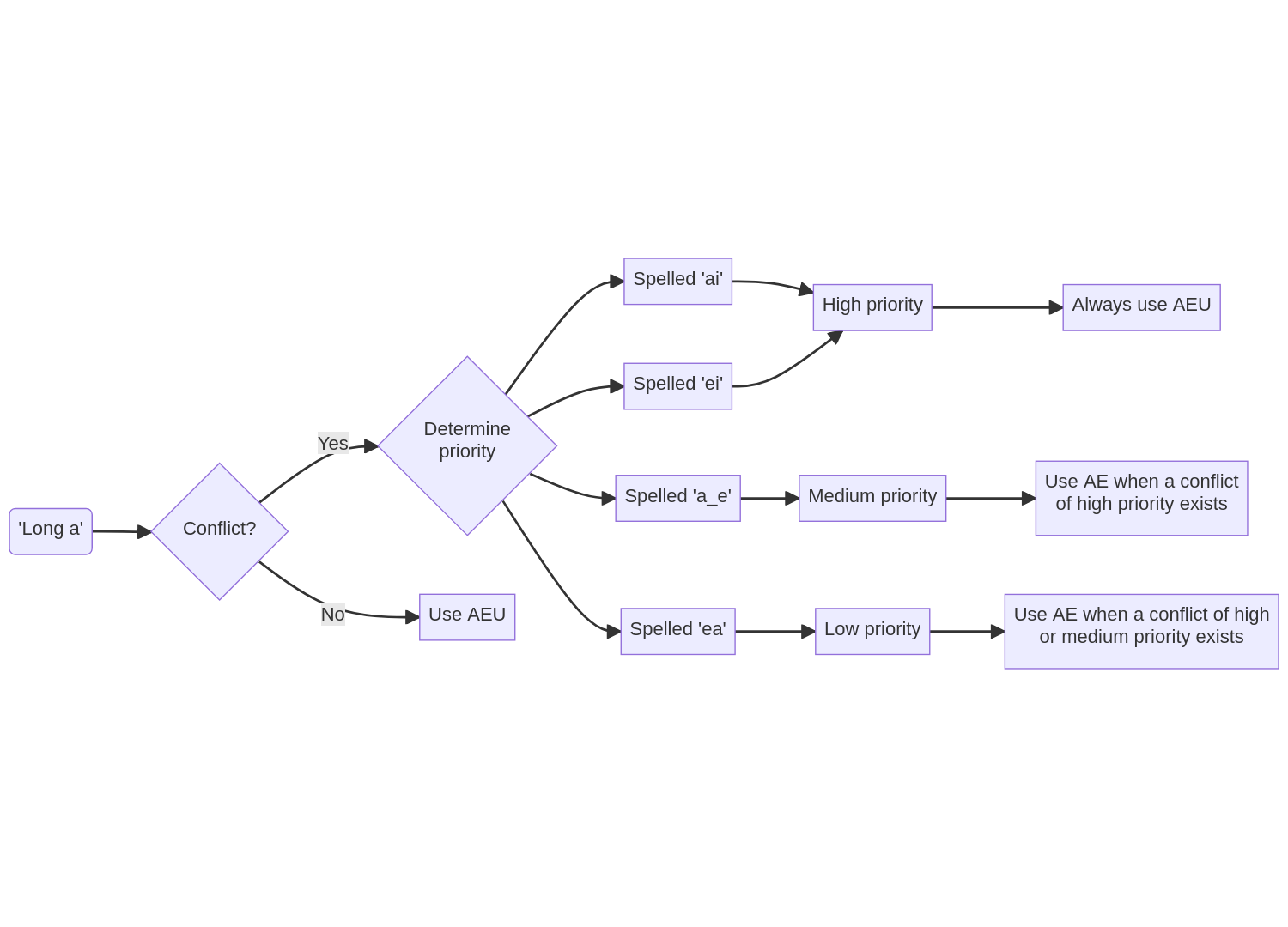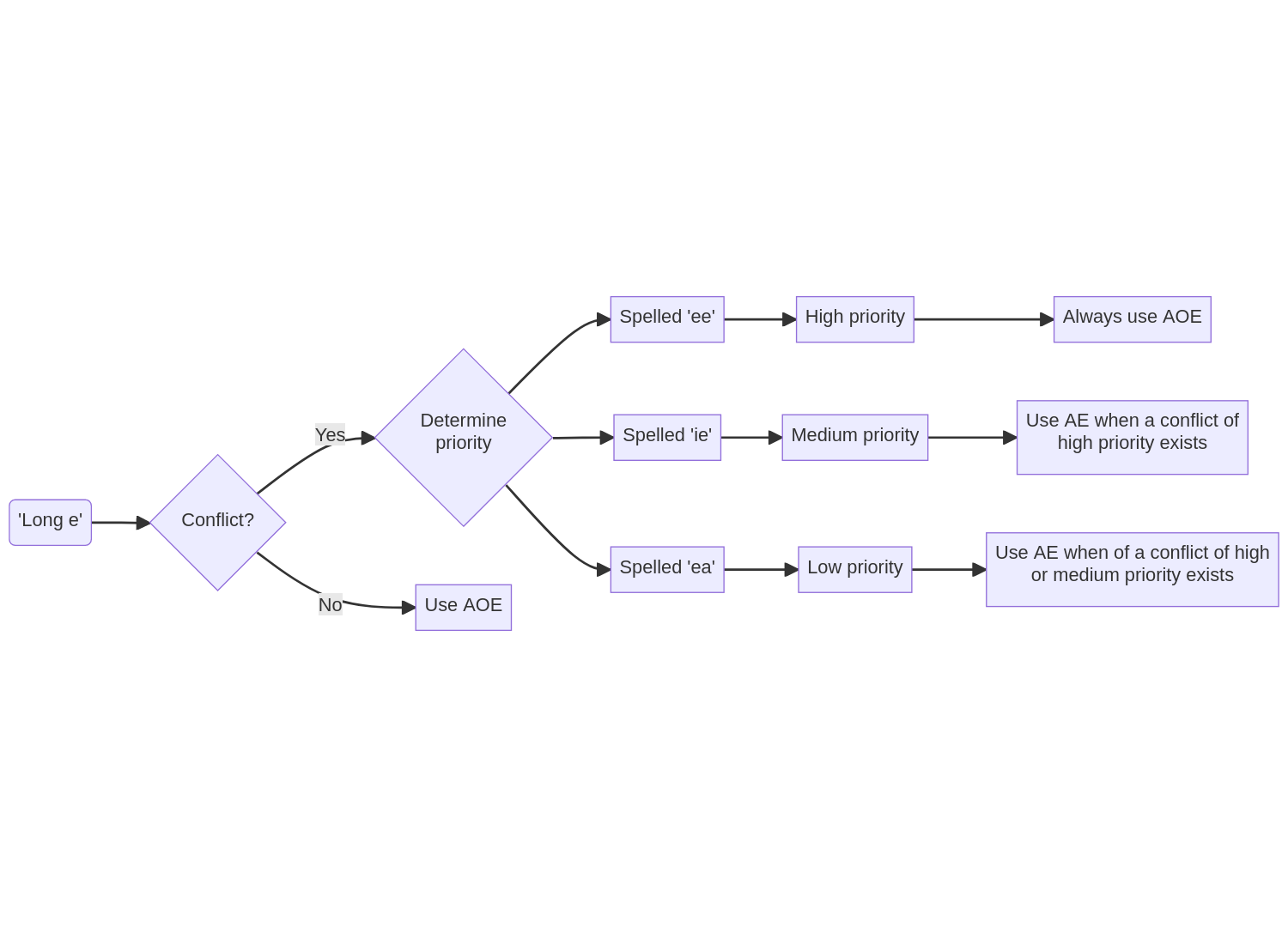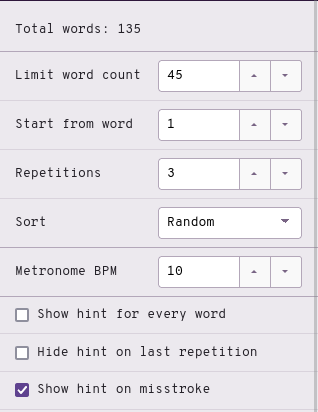Chapter 8: Vowels continued
Useful links
- Single syllable
AOEwords drill - Single syllable
AOEUwords drill - Single syllable
AUwords drill - Single syllable
AEwords drill - Single syllable
AE,AEU, andAOEwords drill - Single syllable
AOwords drill - Chapter 8 test
Intro
Vowels are reportedly the most difficult part of learning steno. Part of this is due to the fact that vowels are pronounced differently in different dialects of English. Unfortunately, I grew up learning General American English. This is the accent that Lapwing is based on.
If you speak a different accent, you may have to subvocalize with an American accent (sorry).
I’m making an effort to include IPA with the hopes that they will be useful for some. However, I must make the disclaimer that I have never taken a formal linguistics course nor am I an enthusiast. I apologize for any errors that may be present in this page—do reach out to me if you have corrections!
What is a conflict?
Since steno is a primarily phonetic system, homophones can be tricky to deal with. For example, the words “pair” and “pear” are pronounced exactly the same, but it is not possible to assign them both to PAEUR. We would call this an example of a conflict; two words conflict with the same outline. In Lapwing theory, spelling is the primary way to resolve conflicts. This particular example of “pair” and “pear” is covered later in this chapter.
AOE
AOEis the long e sound as in “beet”- /i/
AOERis the sound as in “peer”- /ɪər/
Examples
- peel
PAOEL - teal
TAOEL - here
HAOER - seer
SAOER
Mnemonics
Feel free to come up with your own or even suggest some!
- If the notion of long vowels and short vowels (as described in the previous chapter) is familiar, you can think of transforming the
Ekey into a long e by combining it with the two keys on the other side- Long e =
E+ (vowel keys on other hand)
- Long e =
Section practice
Single syllable AOE words drill
AOEU
AOEUis the long i sound as in “ice”- /aɪ/
AOEURis the sound as in “ire”- /aɪər/
Examples
- light
HRAOEUT - tile
TAOEUL - liar
HRAOEUR - tire
TAOEUR
Mnemonics
Feel free to come up with your own or even suggest some!
- If the notion of long vowel and short vowels (as described in the previous chapter) is familiar, you can think of transforming the “i” chord into a long i by combining it with the two keys on the other side
- Long i =
EU+ (vowel keys on other hand)
- Long i =
Section practice
Single syllable AOEU words drill
AU
In chapter 5, the short vowel rules suggest that words like “bought” and “caught” would use the O key.
Short vowel rule #1: short vowel sounds and schwa spelled with a single letter use the key/chord that matches the spelling.
Short vowel rule #2: Short vowel sounds spelled with multiple letters use the key/chord that matches the sound.
However, “bought” and “caught” are homophones with “bot” and “cot” (at least with the accent Lapwing assumes). Therefore, we instead give an exception to the short o sound with regard to the two rules above.
The short o sound is only written with O if it is spelled with a single “o”. Any other spellings of the short o sound are written with AU.
So while “bot” and “cot” are written as PWOT and KOT, respectively, “bought” and “caught” are written like so:
- bought
PWAUT - caught
KAUT
Minor conflicts
Words spelled with “au” are given A*UL when there is a conflict:
- call
KAUL - caul
KA*UL - hall
HAUL - haul
HA*UL
Words spelled with “awl” are also given A*UL when there is a conflict:
- all
AUL - awl
A*UL - ball
PWAUL - bawl
PWA*UL
There aren’t very many of these conflicts to warrant a practice drill, but it is important to keep this in mind when you encounter unexpected output in everyday writing. This is also one area where it is completely safe to change the logic and remap words in your own personal dictionary.
Section practice
Single syllable AU words drill
AE for AEU
Take a look at the following words:
- pair
- pear
The PAEUR outline cannot be assigned to both of these words. This is where AE comes into play. It is a secondary chord that can represent the same vowel as AEU when there is conflict.
In these conflicts involving the long a sound, one word will use AEU. This is the word with higher priority. The other word will use AE; this is the word with lower priority. Spelling is used to determine the priority to assign to a word.
Highest priority: “ai” or “ei” spellings
Words spelled with “ai” or “ei” get the highest priority, and are always written using AEU:
AEUTeightTPAEURfairPHAEUPBmainPAEURpair
Medium priority: “a_e” spellings
These words receive medium priority. Use AE for these words if there is a conflict with a word in the above category.
AETate (AEUTis already “eight”)TPAERfare (TPAEURis already “fair”)TAEURtare (“tair” is not a word)PHAEPBmane (PHAEUPBis already “main”)
Lowest priority: “ea” spellings
These words get lowest priority. If there is a conflict with any of the two categories above, use AE.
TAERtear (TAEURis already “tare”)PAERpear (PAEURis already “pair”)SWAEURswear (“swair” and “sware” are not words)
NOTE: remember that
AEis only used to resolve conflicts. Try not to associate this chord with any specific spelling or sound.
Flowchart Summary
Here’s a flowchart to summarize the above:

AE for AOE
In addition to the AEU vowel, AE can also represent the AOE vowel when there are conflicts. Again, certain spellings are assigned to higher priority, while lower priority spellings use AE.
Highest priority: “ee” spellings
All words spelled with “ee” use AOE
TPAOETfeetPAOEpeeSAOEDseedTAOEtee
Medium priority: “ie” spellings
PAOESpiece
Lowest priority: “ea” spellings
TPAETfeat (TPAOETis already “feet”)PAEpea (PAOEis already “pee”)PAESpeace (PAOESis already “piece”)TAEtea (TAOEis already “tee”)
Flowchart Summary
Here’s a flowchart to summarize the above:

Other uses of AE for disambiguating
AE can also be used for “ea” spellings that conflict with short vowels.
- lead
HRAED(HREDis already “led”) - bread
PWRAED(PWREDis already “bred”)
AE 3-way conflicts
You may wonder about, or even encounter a few 3-way conflicts. For example, “pair”, “pare”, and “pear”. There really aren’t that many of these so Lapwing doesn’t actually provide any rules on how to deal with these.
By default the Lapwing dictionary assigns PAER to “pear” and PA*EUR to “pare”. The reason for this is that “pear” is much more common and is considered higher priority than “pare”. You are, of course, free to disagree with this logic and change things around! It is really up to you how you want to deal with these conflicts.
NOTE: considering priority based on how common words are is generally used as a last resort where the rules are fuzzy or nonexistent (like in this example). You will not see this in any concrete Lapwing rules.
Section practice
Single syllable AE words drill
Single syllable AE, AEU, and AOE words drill
AO
This chord has two uses:
- Words spelled with “oo”, regardless of their pronunciation
- wood
WAOD - hood
HAOD - blood
PWHRAOD - tool
TAOL
- wood
- Words spelled with “oa” to resolve conflicts
- oar
AOR(ORis already “or”) - soar
SAOR(SORis already “sore”) - boar
PWAOR(PWORis already “bore”) - road
RAOD(ROEDis already “rode”)
- oar
NOTE: you may be tempted to write “boat” as
PWAOT, but this is incorrect. The word “boat” should be written asPWOET, first and foremost (since there are no homophones with “boat”). Therefore,PWAOTis actually the word “boot”.
Section practice
Single syllable AO words drill
Chapter 8 test
This chapter’s test consists of all the vowel drills (including chapter 7 material). Make sure your settings are configured as such:

- Limit word count: 45
- Start from word: 1
- Repetitions: 3
- Sort: random
- Show hint for every word: unchecked
- Hide hint on last repetition: unchecked
- Show hint on misstroke: checked
Click here to access the chapter 8 test
Recommended completion goal
This is only a suggestion if you are unsure of when to move on to the next chapter; it is not a strict requirement!
Aim for 5–20 WPM with 90% accuracy.
You may use the test material as practice!
Chapter briefs
This section is completely optional, but recommended. If you prefer to learn these all at once, they will be covered in chapter 16.
| Word | Brief | Explanation |
|---|---|---|
| had | H | Single key brief for a common word |
| people | P | Single key brief for a common word |
| this | TH | this |
| there | THR | there |
| when | WH | when |
| why | KWH | KWH is the initial “y” chord |
| will | HR | will |
| with | W | Single key brief for a common word |
Enter or Return | R-R | return (equivalent to pressing Enter or Return on a keyboard). |
Capitalize the next word and suppress a space | KPA* | This useful for starting new sentences in text fields where you don’t want a leading space. |
NOTE: remember that these are briefs; the explanations are not applicable to any arbitrary word.
Practice sentences
- When are the people here?
- This is why we fight.
- There are no moose!
- Will you sleep now?
- I have had it with you!
Answers
KPA*/WH/R/-T/P/HAOER/KW-PLKPA*/TH/S/KWH/WAOE/TPAOEUT/TP-PLKPA*/THR/-R/TPHO/PHAOS/TP-BGKPA*/HR/U/SHRAOEP/TPHOU/KW-PLKPA*/EU/SR/H/T/W/U/TP-BG
Extra briefs
| Brief | Outline | Explanation |
|---|---|---|
| had the | H-T | H + -T |
| this is | TH-S | TH + -S |
| there is | THR-S | THR + -S |
| there’s | THR*S | THR + -S + * |
| there are | THR-R | THR + -R |
| there’re | THR*R | THR + -R + * |
| when is | WH-S | WH + -S |
| when’s | WH*S | WH + -S + * |
| when are | WH-R | WH + -R |
| why is | KWH-S | KWH + -S |
| why’s | KWH*S | KWH + -S + * |
| why are | KWH-R | KWH + R |
| will the | HR-T | HR + -T |
| will you | HRU | HR + U |